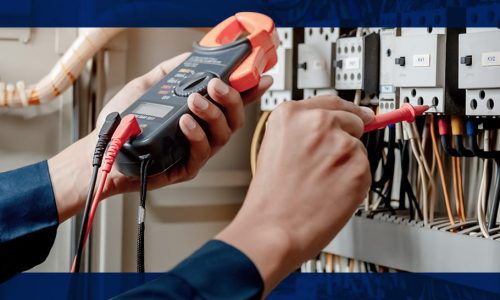Electrical Ladder Safety: 11 Tips to Avoid Shocks and Falling
Ladders are an essential tool for electricians and electrical contractors. A ladder is essential for any task, whether it’s pulling wire through conduit or installing a fixture. Even if you think that you are familiar with the OSHA safety rules and all about ladder safety, accidents can still happen.
According to the Bureau of Labor Statistics (BLS), more than 100 workers are killed and thousands injured by ladder accidents every year. Do not let a ladder injury keep you from working or even worse, off the job. These tips will help you avoid shocks or falls caused by ladders.
Select a fiberglass ladder
Why do electricians use fiberglass ladders? These ladders are more expensive, but they’re non-conductive and therefore, unlike aluminum, electricity cannot pass through them. This prevents electric shock for workers in the case that the ladder comes into contact with a live cable.
Wooden ladders that are wet can conduct electricity. Fiberglass ladders have several other advantages compared to wooden ladders. They are more rigid, durable, and resistant to weather. Some fiberglass ladders were designed for electricians and include features like hooks, pole grabs and plastic trays to hold tools.
Use ladders only on stable, level ground
Set up your ladders on level ground. Otherwise, you increase the chance of it tipping while you are on it. Use a ladder leveler if the ground is uneven.
Keep ladders clear of electrical lines
OSHA’s ladder safety guidelines state that a ladder must be placed far enough from power lines to prevent it from making contact, even if the ladder tips over or falls. Metal ladders should never be used near power lines, or exposed electrical equipment.
Be aware of the duty classification
The duty rating defines the maximum weight that the ladder can support. This weight includes your body, any PPE you are wearing and any tools or supplies you may be carrying. There are five different duty ratings for ladders, and the maximum load capacity is shown below. The majority of electricians will need at least a Type I ladder.
Before each use, inspect the ladder
Check for structural damage. Look out for missing or loose steps. Check that the ladder is free of oil, grease, and other debris which could cause your boots to slip.
When setting up the ladder, follow the rule of 4 to 1.
Placement of an extension ladder at a proper angle will increase stability. OSHA recommends that a ladder not self-supporting be set at a 75.5 degree angle. This translates into a 4:1 ratio between the working length of the ladder and the set-back distance. Place the ladder 1 foot from a wall or vertical surface per 4 feet of the working length.
Bubble indicators are available on some ladders to help you determine the right angle. The National Institute for Occupational Safety and Health’s smartphone app has a tool for measuring the angle. It is possible to estimate the angle by using your arms. Stand at the bottom of the ladder, with your toes on the rails. Reach out both arms. You should only be able to touch the rungs at shoulder level.
Don’t climb the top
Climb no higher than the third tread or rung of a ladder extension.
Maintaining three points of contact
Always keep two hands or two feet on the ladder. You may find it tempting to let go so that you can use both hands. But don’t do it. Your tools can be carried in a tool belt or raised using a handline.
To increase safety, tie off a ladder extension
Tie the extension ladder down when you are using it to reach a roof, utility pole or other high place. This will prevent it from sliding or slipping. How do you tie off a safety ladder? Electricians use a variety of tools, including cable hooks and V-rungs. They also often use pole laces, tie-off straps and pole lashes. Choose a strong anchor point.
Use the 3-foot rule to access elevated services
OSHA requires that if you are using a ladder to reach a roof, or any other elevated surface, it must extend 3 feet beyond the level of the access.
Increase stability with accessories
There are many ladder accessories available, including those that can be used to secure the ladder. There are ladder stabilizers that look like handlebars or “grip” walls. They come in different types.


